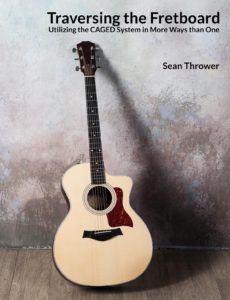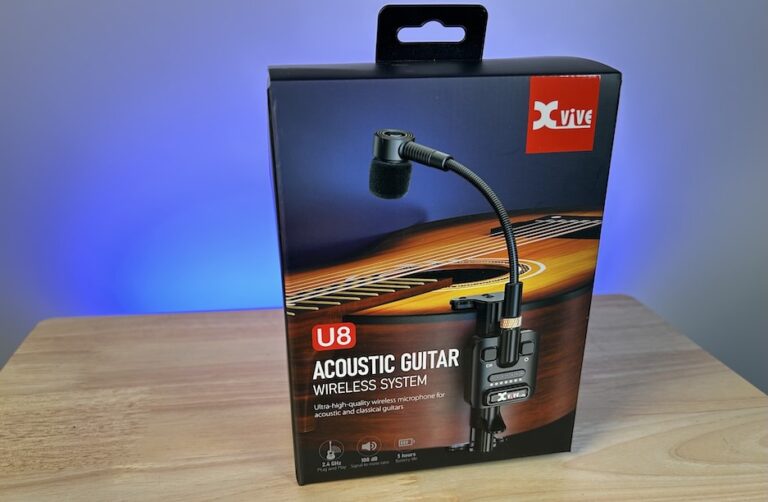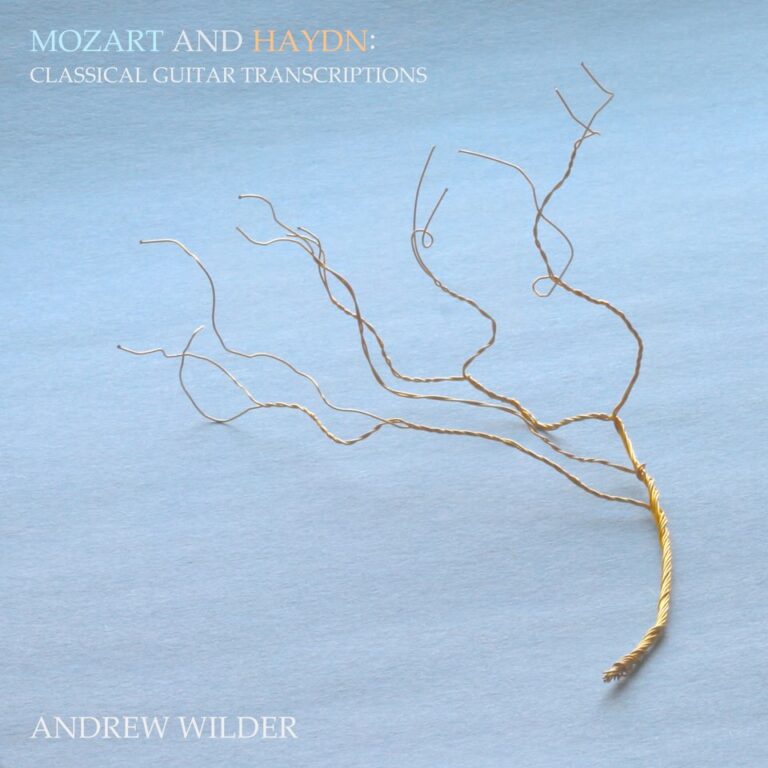Traversing the Fretboard
Utilizing the CAGED System in More Ways than One.
by Sean Thrower
Buy the book via Amazon: Traversing the Fretboard
I was very pleased to receive a copy of Sean Thrower’s new book focusing on fretboard theory and knowledge. Thrower is a guitarist and teacher holding a Bachelor’s and Master’s degree in classical guitar performance from the University of Georgia. He also does some singing/songwriting as well. He is currently on staff as Adjunct Professor of Guitar at Berry College in Rome, Georgia.
Here’s the promotional blurb about his book:
Traversing the Fretboard is designed to help guitarists of all levels and styles of playing strengthen their understanding of how notes are organized across the fretboard. This method uses the CAGED System to build and demonstrate a connection between chord shapes and scale patterns. It also shows how the CAGED System can act as the foundation for forming seventh chords, finding and playing open and closed voicings, and discussing music theory. Along the way, there are many engaging musical examples from a variety of genres to offer a diverse application of the ideas discussed in each chapter. This book can help the beginner move beyond first position, offer new conceptual ideas to the seasoned guitarist, provide insight into improvisation and composition, help strengthen sight-reading and memorization, and connect guitarists to a wider range of musical styles.
Some Positive Observations
Practicality First: One of the best things about this book is how it is organized in an engaging way for students, especially for guitarists who already know a few things but want to dive deeper into the fretboard. For example, the chords section relates common first position chord shapes (the ones everyone knows from the beginning, aka folk singer chords) to triadic moveable shapes that traverse the fretboard. This is more engaging to students because they will memorize moveable shapes in relation to shapes they already know and will probably understand the usefulness of moveable chords right off the bat. Compare this to diving into all the triads and inversions in encyclopedic books which can be difficult to memorize and painfully boring (think The Fisher Jazz book). Same goes for the scale section. The book is more focused, at least at first, on relating concepts rather than encyclopedic knowledge. Then, once some concepts are established the book dives into all the relevant patterns and shapes needed for a thorough knowledge. Here’s a video exploring some of these ideas:
Multi-Stylistic Application: This book is for all styles and genres of guitar. There are also helpful bits of advice for different types of players. For example, tips for using certain chord voicing when playing bands or how to analyze classical works such as Legnani Caprices. At times it might seem more geared toward the popular music guitarist with, for example, the scale section starting with pentatonic scales. However, pentatonic scales are just as relevant to classical music as to any other music and Thrower explores both improvisational application as well as compositional uses such as a look at Debussy. Truthfully, as a teacher, I know that if I don’t have students improvise with scales they don’t truly understand the usage or it’s relationship to chords. They will get it eventually if they take their theory classes but improvisation or seeing direct application in compositions engages the students both in the their ears and brain.
Student Engagement: If there is one point I keep coming back to it is that Thrower’s book is very practical and engaging in the practice room. As a teacher I really appreciate that aspect because it means I can engage with my students and the material in a meaningful way rather than just assign the pages and hope for the best. I’m not sure if self-study students will get as much from it but, if motivated, they could.
CAGED system: I don’t know if the book needs to emphasize the CAGED system when really, it is in such widespread usage as to be simply a part of guitar education. However, for those of you who doesn’t know it, it simply divides the fretboard into five boxes manageable by the left hand without shifts. As Thrower states: “Memory is formed more easily when information is organized into groups…” I totally agree and as a classical guitarist I high emphasize this as a technique foundation as well. Just as Thrower teaches you the box patterns and then how to break out of them and combine across the fretboard, technique practice can be handled the same way. I could certainly link this book up with most of my classical pedagogy books. In some ways you can just think of the CAGED system in this book as being a stamp of utility in terms of how you’ll be able to assimilate the information.
Notation, TAB, Diagrams: Concepts, chords, and scales generally use diagrams while examples and pieces use notation and tablature (TAB). When it comes to this kind of learning I think whatever is most clear is best. In the end, if you want to work specifically on your reading skills there are other books out there. This book will help with reading if you really link up what you learn and then examine the pieces and examples using the notation. Keep your eyes off the tab if you want to absorb it musically. Nevertheless, the tab will help you see the pattern on the guitar and to clarify examples if you’re confused.
Problems & Solutions
The exact reason I personally like this book (universal knowledge, multi-stylistic, openly exploratory) may make it less practical to students looking to achieve specific playing goals such as the art of jazz. However, any book focused on one genre or style is likely to leave out the big picture in terms of how music universally works. Similarily, genre specific books might not make the connection to music history and the development and idiomatic uses of music theory on the guitar as it has evolved over the centuries. However, this is easily fixed: use this book as your fretboard theory book and a supplemental book to learn specifics and your own personal interests. Think of the university student as an example: university students all take the same theory, musicianship, and history classes and then explore more of their personal tastes in their private lessons while a teacher ensures they get a well-rounded education. So I would consider this book to be more like the universal courses that musicians simply need to take in order to understand music on their instrument.
Self-Study vs Using this Book with a Teacher: Every book is more engaging and better understood with a teacher. Nothing will ever change that. One of the big problems of today’s commercial invasion of music education is that books are more and more geared toward self-study. So widespread is this phenomenon that many books are nearly unusable by teachers because of they lack flexibility in regards to teaching styles. However, as far as books go today, I would place this book in the middle and say it’s decent for both self-study and with a teacher. There is nothing in this book that would interfere with teaching outside of the usual little elements such as different choices for fingering etc. However, the self-study student will appreciate the large amount of text included in the book which covers more than just technical details. The best thing about the text is that Thrower often explains the context and usage of the musical element being discussed. Context is the thing that teachers pass on to their students and this book gets top marks in that regard.
Conclusion
Traversing the Fretboard by Sean Thrower integrates practicality with thorough knowledge to create a book of great use to students and teachers alike. Its multi-stylistic approach with examples and exercises ranging from classical, jazz, rock, folk and more make it a universally useful contribution to educational guitar materials. The book approaches fretboard knowledge from the student’s perspective making it a welcomed addition to the practice room, teaching studio, or classroom.





